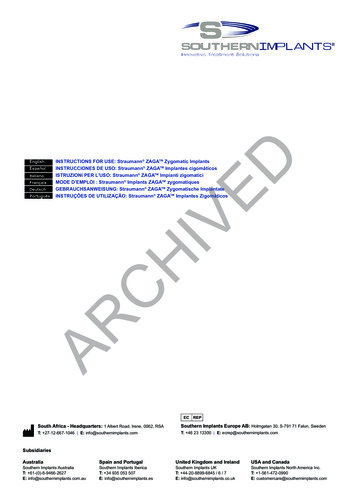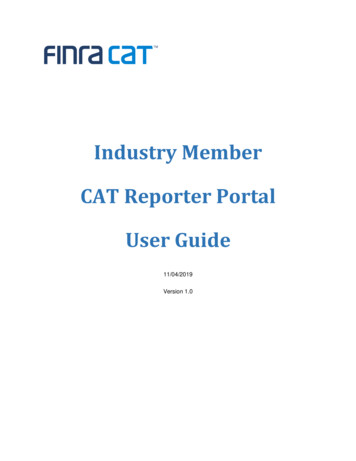
Transcription
EspañolItalianoFrançaisDeutschINSTRUCTIONS FOR USE: Straumann ZAGATM Zygomatic ImplantsINSTRUCCIONES DE USO: Straumann ZAGATM Implantes cigomáticosISTRUZIONI PER L’USO: Straumann ZAGATM Impianti zigomaticiMODE D’EMPLOI : Straumann Implants ZAGATM zygomatiquesGEBRAUCHSANWEISUNG: Straumann ZAGATM Zygomatische ImplantateINSTRUÇÕES DE UTILIZAÇÃO: Straumann ZAGATM Implantes ZigomáticosARCHIVPortuguêsEDEnglishSouth Africa - Headquarters: 1 Albert Road, Irene, 0062, RSASouthern Implants Europe AB: Holmgatan 30, S-791 71 Falun, SwedenT: 27-12-667-1046 E: info@southernimplants.comT: 46 23 13300 E: thern Implants AustraliaT: 61-(0)-8-9466-2627E: info@southernimplants.com.auSpain and PortugalSouthern Implants IbericaT: 34 935 053 507E: info@southernimplants.esUnited Kingdom and IrelandSouthern Implants UKT: 44-20-8899-6845 / 6 / 7E: info@southernimplants.co.ukUSA and CanadaSouthern Implants North America Inc.T: 1-561-472-0990E: customercare@southernimplants.com
INSTRUCTIONS FOR USE: Straumann Zygomatic ImplantsIntended useThe Zygomatic implants are intended to treat partially or fully edentulouspatients with severely resorbed or absent maxillae for whom conventionalimplants are not an option as a means of fixing a permanent or removabledental or maxillofacial prosthesis.DescriptionThe Straumann Zygomatic Implant system includes the Straumann Zygomatic Implant, ZAGA Round and the Straumann ZygomaticImplant, ZAGA Flat. They are extra-long (up to 55mm) to enablebone anchorage in the zygoma, and have a 55 head angle. They aremade from biocompatible, commercially pure, Grade 4 Titanium andare available in a range of lengths to be used with a range of prostheticcomponents. The apical threaded region of the implants are roughenedfor bone anchorage, while the coronal region has a smooth machinedsurface. This implant system is delivered pre-mounted with a fixturemount. All implants are appropriate for immediate loading when goodprimary stability is achieved and with appropriate occlusal loading.Indications for useStraumann Zygomatic Implants are intended to be implanted in theupper jaw arch to provide support for fixed dental prostheses in patientswith partially or fully edentulous maxillae. All implants are appropriatefor immediate loading when good primary stability is achieved andwith appropriate occlusal loading. This implant system is not intended,nor should it be used, in conjunction with an angled abutment. Theseimplants are not intended for single unit loading.Storage, cleaning & sterilisationThe implants, cover screws and healing abutments are supplied sterile(sterilised by gamma irradiation) and intended for single-use prior to theexpiration date (see packaging label). Sterility is assured unless thecontainer or seal is damaged or opened. If packaging is damaged donot use the product and contact your Southern representative/ or returnto Southern Implants. Do not reuse implants, cover screws, temporaryabutments and abutments. Re-using these components may resultin damage on the surface or critical dimensions, which may result inperformance and compatibility degradation. Southern Implants doesnot accept any responsibility for complications associated with reusedcomponents.IVContraindicationsDo not use in patients:who are medically unfit for oral surgical procedures.who are allergic or have hypersensitivity to pure titanium ortitanium alloy (Ti-6AL-4V).with inadequate bone volume or quality for zygomatic andconventional implants.where adequate numbers of implants could not be placed toachieve full functional support for a prosthesis.who have undergone irradiation of maxillary bone.who are under the age of 18, Poor bone quality, Blood disorders,Infected implant site, Vascular impairment, Uncontrolleddiabetes, Drug or alcohol abuse, Chronic high dose steroidtherapy, Anti-coagulant therapy, Metabolic bone disease,Radiotherapy treatment, Sinus pathologyCautionsNew and experienced implant users should do training before using anew system or attempt to do a new treatment method. Take special carewhen treating patients who have local or systemic factors that couldaffect the healing of the bone and soft tissue.Thorough screening of prospective implant candidates must beperformed including:a comprehensive medical and dental history.visual and radiological inspection to determineadequatebone dimensions, anatomical landmarks, occlusal conditions,periodontal health.bruxism and unfavourable jaw relations must be taken into account.proper pre-operative planning with a good team approach betweenwell trained surgeons, restorative dentists and lab technicians isessential for successful implant treatment.minimizing the trauma to the host tissue increases the potential forsuccessful osseointegration.electro-surgery should not be attempted around metal implants asthey are conductive.EDEnglishCHPrecaution: Maintain the sterility of the implant1. Care must be taken to maintain the sterility of the implant byproper opening of the packaging and handling of the implant.2. The outer rigid plastic box and the outside of the inner plastictray-lid are not sterile; do not touch the outside with sterilegloves, and do not place the plastic box or inner plastic tray-lidonto the sterile field.3. The packaging for the implant is the same as that for previousSouthern Implants zygomatic implants in that there is nosecondary rigid container inside the sterile tray. Instead, there isa stainless steel clip that supports the implant and fixture mount,keeping the implant from contact with the container.4. Inside the plastic box the sealed inner plastic tray-lid is sterileonly on the inside. The sealed tray-lid is to be opened by anassistant (with nonsterile gloves): remove the lid and do nottouch the sterile implant.5. Maintain the sterility of the implant, after opening the tray andremoving the implant, until placement in the surgical site.ARWarningsTHESE INSTRUCTIONS ARE NOT INTENDED AS ASUBSTITUTE FOR ADEQUATE TRAININGFor the safe and effective use of dental implants it is stronglysuggested that specialised training be undertaken, includinghands-on training to learn proper technique, biomechanicalrequirements and radiographic evaluations.Products must be secured against aspiration when handledintraorally. Aspiration of products may lead to infection orunplanned physical injury.Responsibility for proper patient selection, adequate training, experiencein the placement of implants, and providing appropriate informationfor informed consent rests with the practitioner. Improper techniquecan result in implant failure, damage to nerves/vessels and/or loss ofsupporting bone. Implant failure increases when implants are placedin irradiated bone as radiotherapy can result in progressive fibrosis ofvessels and soft tissue, leading to diminished healing capacity.Additionally, use of Zygomatic Implants in bone tissue which has beenirradiated as part of cancer therapy may result in the following:delayed or failed osseointegration of implants due to duced bonevascularity, clinically expressed as osteoradionecrosis.tissue dehiscence and osteoradionecrosis.implant failure and loss.implant treatment of irradiated patients is dependent upon issueslike the timing of implant placement in relation to the radiationtherapy, anatomic site chosen for implant placement and radiationdosage at that site and consequent risk of osteoradionecrosis.CAT-8049-01 (C1295) 13/03/2021During surgeryCare must be taken that parts are not swallowed or aspiratedduring any of the procedures, thus rubber-dam application isrecommended when appropriate.Care must be taken to apply the correct tightening torque ofabutments and abutment screws. Post-surgery:Regular patient follow-up and proper oral hygiene must beachieved, and are essential for favorable long-term results.Pre-operative examination and planningA full medical and dental history must be taken, with emphasis on thepresence of soft and or hard tissue pathology. The patient must haveclinically symptom-free sinuses and no pathology in surrounding boneor soft tissue. It is recommended that a CT scan and/or CBCT analysisbe performed as part of the planning process in order to:detect the presence of any pathology in the maxillary sinuses.determine bone volume and condition.determine jaw relationships.zygomatic implants are recommended for the posterior (premolar/molar) region, one implant on each side, with at least two2
English-INSTRUCTIONS FOR USE: Straumann Zygomatic Implantsstandard dental implants in the anterior region to support a fixedrestoration.where there is insufficient bone for good stability of anteriorimplants, a quad Zygomatic protocol is indicated. This involvestwo Zygomatic implants per Zygoma with both of these implantsangled to emerge in the anterior region.EDSurgical Procedure for Straumann Zygomatic Implants, ZAGA RoundARCHIVA crestal incision is made from just anterior to the maxillary tuberosity on one side to the same point on the other side. Three verticalreleasing incisions are made in the second molar regions and the midline. These 3 incisions facilitate flap mobilization beyond the infraorbital margin.In unilateral cases a hemi-maxillary approach is used. The buccal mucoperiosteal flaps are raised to expose the infraorbital nerve, the body of thezygoma and the zygomatic arch. A palatal flap is raised to expose the alveolar bone. The periosteum in the region of the upper molar teeth is incisedto enhance flap mobility. A channel retractor is placed on the upper border of the zygomatic arch.1. A small sinus window is cut on the lateral aspect of the maxillary sinus and the block of the bone is removed (Fig 1). The lining of the sinusis reflected, attempting to keep it intact if possible. Thorough reflection of the lining is essential.2. Begin the entrance point of the implant (site preparation) for the Straumann Zygomatic Implant, ZAGA Round at the first- second premolar area on the maxillary crest and follow the posterior maxillary wall. Aim to end just in front of the fronto-zygomatic notch.3. The entrance point on the alveolus is made using a round bur (D-ZYG-RB) or a needle drill (026.0054) and continued through the wall ofthe maxillary sinus to the cavity seen through the sinus window (Fig 2) (D-ZYG-RB recommended drill speed: 1000-1500rpm; 026.0054maximum drill speed: 800rpm).4. The implant site is established by means of the Ø2.9mm twist drill (D-ZYG-29/ D-ZYG-29S/ D-ZYG-CH-29/ D-ZYG-CH-29S), and continuedinto the zygoma (Fig 3) (D-ZYG-29/ D-ZYG-29S/ D-ZYG-CH-29/ D-ZYG-CH-29S recommended drill speed: 1000-1500rpm). The sinuswindow gives view to the correctly positioned penetration of the drills into the zygoma. Emergence of the drill out the zygoma is palpated on5.6.7.8.the cheek of the patient.The Ø3.5 D-35T-M15 drill is then used to enlarge the hole in the alveolar ridge (Fig 4). (D-35T-M15 recommended drill speed: 10001500rpm) Do not use this drill in soft bone as the implant will prepare the alveolar site as it is pushed through in the next step. Finally, anoval cut is made extending slightly buccal to the palatal alveolar emergence hole to allow for the prosthodontic restoration of the implanthead.The depth of the prepared implant site and the implant head angulation are gauged by use of the angled depth gauge (CH-IDG/ I-ZYG-DG-1) (Fig 5).Before inserting the implant, ensure that the implant site is free of soft tissue remnants. The handpiece with connector (I-CON-X) is usedfor the initial insertion of the implant, with the torque control set at 50Ncm at 15rpm. Push the Straumann Zygomatic Implant, ZAGA Round straight through the alveolar preparation. You will only need to start screwing when the apex reaches the zygoma, thus reducing theinsertion time. When the handpiece torques out, switch to the surgical wrench (046.108, 046.119, 046.049) or the onion driver (I-ZYG-INS-2/I-IMP-INS-2) (Fig 6). Avoid applying bending moments to the fixture mount while inserting the implant. Check the fixture mount screw forloosening periodically and re-tighten if necessary.CAT-8049-01 (C1295) 13/03/20213
EnglishThe implant must follow the prepared path of insertion. Any soft tissue that may have been picked up on the implant threads while movingthrough the alveolus and sinus must be cleared off before the implant enters the zygomatic placement site. One revolution of the implantresults in 0.8mm axial movement. Insertion is complete when the head is in the correct prosthodontic position and angle.ARCHIVED9.INSTRUCTIONS FOR USE: Straumann Zygomatic Implants10. The fixture mount screw is then loosened with the dedicated screwdriver and the fixture mount is removed (Fig 7).11. Should sufficient primary stability not be achieved for the implant, a cover screw (CH-CS) is placed with the dedicated driver (I-CSHD) fora two-stage protocol. For immediate loading, a screw-retained abutment (CH-SRA) with an appropriate gingival height is picked up andplaced with the dedicated screwdriver (046.401/ 046.411) (Fig 8). Suturing is then carried out according to the surgeon’s preference.12. Caution: Tighten the cover screw (CH-CS) only finger tight to avoid excessive loads. Tighten the screw-retained abutment (CHSRA) to the recommended torque of 35Ncm.CAT-8049-01 (C1295) 13/03/20214
INSTRUCTIONS FOR USE: Straumann Zygomatic ImplantsSurgical Procedure for Straumann Zygomatic Implants, ZAGA FlatEDEnglishARCHIVA crestal incision is made from just anterior to the maxillary tuberosity on one side to the same point on the other side. Three vertical releasingincisions are made in the second molar regions and the midline. These 3 incisions facilitate flap mobilization beyond the infraorbital margin. Inunilateral cases a hemi-maxillary approach is used. The buccal mucoperiosteal flaps are raised to expose the infraorbital nerve, the body of thezygoma and the zygomatic arch. A palatal flap is raised to expose the alveolar bone. The periosteum in the region of the upper molar teeth is incisedto enhance flap mobility. A channel retractor is placed on the upper border of the zygomatic arch.1. A small sinus window is cut on the lateral aspect of the maxillary sinus and the block of the bone is removed (Fig 1). The lining of the sinusis reflected, attempting to keep it intact. Thorough reflection of the lining is essential.2. Begin the entrance point of the implant (site preparation) for the Straumann Zygomatic Implant, ZAGA Flat at the first-second pre-molararea on the maxillary crest and follow the posterior maxillary wall. Aim to end just in front of the fronto-zygomatic notch.3. The entrance point on the alveolus is made using a round bur (D-ZYG-RB) or a needle drill (026.0054) and continued through the wall ofthe maxillary sinus to the cavity seen through the sinus window (Fig 2). (D-ZYG-RB recommended drill speed: 1000-1500rpm; 026.0054maximum drill speed: 800rpm)4. The implant site is established by means of the Ø2.9mm twist drill (D-ZYG-29/ D-ZYG-29S/ D-ZYG-CH-29/ D-ZYG-CH-29S), and continuedinto the zygoma (Fig 3). (D-ZYG-29/ D-ZYG-29S/ D-ZYG-CH-29/ D-ZYG-CH-29S recommended drill speed: 1000-1500rpm) The sinuswindow gives view to the correctly positioned penetration of the drills into the zygoma. Emergence of the drill out the zygoma is palpated onthe cheek of the patient.5. Use the ZAGA Side Cut Burr (CH-D-CM) to create and/or enlarge the groove made in the alveolar ridge in order to place the implant withthe buccal face sitting flush with the alveolar bone outer surface (Fig 4) (CH-D-CM recommended drill speed: 1000-1500rpm).6. The depth of the prepared implant site and the implant head angulation are gauged by the use of the angled depth gauge (CH- I-DG/ I-ZYGDG-1) (Fig 5).CAT-8049-01 (C1295) 13/03/20215
INSTRUCTIONS FOR USE: Straumann Zygomatic ImplantsEDEnglishBefore inserting the implant, ensure that the implant site is free of soft tissue remnants. The handpiece with connector (I-CON-X) isused for the initial insertion of the implant, with the torque control set at 50Ncm at 15rpm. Push the Straumann Zygomatic Implant,ZAGA Flat straight through the alveolar preparation. You will only need to start screwing when the apex reaches the zygoma, thusreducing the insertion time. When the handpiece torques out, switch to the surgical wrench (046.108, 046.119, 046.049) or the oniondriver (I-ZYG-INS-2/ I-IMP-INS-2) (Fig 6).8. Avoid applying bending moments to the fixture mount while inserting the implant. Check the fixture mount screw forloosening periodically and re-tighten if necessary.9. The implant must follow the prepared path of insertion. Any soft tissue that may have been picked up on the implant threads whilemoving through the alveolus and sinus must be cleared off before the implant enters the zygomatic placement site. One revolution ofthe implant results in 0.8mm axial movement.10. Insertion is complete when the head is in the correct prosthodontic position and angle. The fixture mount screw is then loosened withthe dedicated screwdriver and the fixture mount is removed (Fig 7).11. Should sufficient primary stability not be achieved for the implant, a cover screw (CH-CS) is placed with the dedicated driver (I-CSHD)for a two-stage protocol. For immediate loading, a screw-retained abutment (CH-SRA) with an appropriate gingival height is pickedup and placed with the dedicated screw driver (046.401/ 046.411) (Fig 8). Suturing is then carried out according to the surgeon’spreference.12. Caution: Tighten the cover screw (CH-CS) only finger tight to avoid excessive loads. Tighten the screw-retained abutment(CH-SRA) to the recommended torque of 35Ncm.ARCHIV7.CAT-8049-01 (C1295) 13/03/20216
INSTRUCTIONS FOR USE: Straumann Zygomatic ImplantsWarningIt is very important to be aware and avoid damage to vital structures suchas nerves, veins and arteries. Injuries to vital anatomical structures maycause serious complications like injury to the eye, nerve damage andexcessive bleeding.It is essential to protect the infraorbital nerve. Failing to identifyactual measurements relative to the radiographic data could lead tocomplications.abutment angles greater than 30 degrees, occlusal interferences causingexcessive lateral forces, patient parafunction (e.g., bruxing, clenching),loss or changes in dentition or functionality, inadequate prosthesis fit,and physical trauma. Additional treatment may be necessary when anyof the above conditions are present to reduce the possibility of hardwarecomplications or failure.Changes in performanceIt is the responsibility of the clinician to instruct the patient on allappropriate contraindications, side effects, and precautions as well asthe need to seek the services of a trained dental professional if there areany changes in the performance of the implant (e.g. looseness of theprosthesis, infection or exudate around the implant, pain, or any otherunusual symptoms that the patent has not been told to expect).IVClinical benefits associated with Zygomatic implantsPatients can expect to have their missing teeth replaced and/ or crownsrestored.EDEnglishMR SafetyThese products have not been tested for MRI safety, however, ananalysis and review of the literature has shown that the risks of scanninga Southern Implants implant system are not of concern under thefollowing conditions:a static magnetic field of 1.5 Tesla and 3 Tesla.a magnetic field with a field gradient of 30T/M (3000G/cm).a whole body specific absorption rate (SAR) of 2W/kg, for 15minutes of scanning.HHealingThe healing time required for osseointegration depends on the individualand treatment protocol. It is the responsibility of the practitioner to decidewhen the implant can be restored. Good primary stability will govern ifimmediate loading can be done.ARMaterialsStraumann ZygomaticImplant:CImplant care and maintenancePotential implant patients should establish an adequate oral hygieneregime prior to Implant therapy. Proper post-operative, oral hygiene andimplant maintenance instructions must be discussed with the patient, asthis will determine the longevity and health of the Implants. The patientshould maintain regular prophylaxis and evaluation appointments.Commercially pure titanium (grade 4,ASTM F67 and ISO 5832-2,UTS 900MPa)Side effectsPotential Side Effects and Temporary symptoms: Pain, swelling, phoneticdifficulties, gingival inflammation. More persistent symptoms: The risksand complications with implants include, but are not limited to: (1) allergicreaction(s) to implant and/ or abutment material; (2) breakage of theimplant and/or abutment;(3) loosening of the abutment screw and/or retaining screw; (4) infectionrequiring revision of the dental implant; (5) nerve damage that couldcause permanent weakness, numbness, or pain; (6) histologic responsespossibly involving macrophages and/or fibroblasts; (7) formation offat emboli; (8) loosening of the implant requiring revision surgery; (9)perforation of the maxillary sinus; (10) perforation of the labial and lingualplates; and (11) bone loss possibly resulting in revision or removal.BreakageImplant and abutment fractures can occur when applied loads exceedthe tensile or compressive strength of the material. Potential overloadingconditions may result from; deficiencies in implant numbers, lengths and/or diameters to adequately supporta restoration, excessive cantilever length, incomplete abutment seating,CAT-8049-01 (C1295) 13/03/2021Storage, Cleaning & SterilizationThe implants are supplied sterile and intended for single use prior tothe expiration date (see packaging label). Sterility is assured unless thecontainer or seal is damaged or opened. Do not re-sterilize or autoclavethese components. This product should be stored, in its originalpackaging, in a clean and dry location, in a maximum temperature of40 C and protected from direct sunlight.DisposalDisposal of the device and its packaging; Follow local regulations andenvironmental requirements, taking different contamination levels intoaccount. When disposing of spent items, take care of sharp drills andinstruments. Sufficient PPE must be used at all times.Disclaimer of liabilityThis product is part of the Southern Implants product range and shouldonly be used with the associated original products and according to therecommendations as in the individual product catalogues. The user ofthis product has to study the development of the Southern Implantsproduct range and take full responsibility for the correct indications anduse of this product. Southern Implants does not assume liability fordamage due to incorrect use. Please note that some Southern Implantsproducts may not be cleared or released for sale in all markets.7
INSTRUCTIONS FOR USE: Straumann Zygomatic ImplantsARCHIVEDEnglishSymbols and WarningsManufacturer: Southern Implants1 Albert Rd, P.O Box 605 IRENE, 0062,South Africa.Tel: 27 12 667 rradiationNon-sterileCautionConsultinstructionfor useUse by date(mm-yy)Do not reuseDo notre-sterilizeBatch codeDo not useif package isdamagedMedicalDevice* Prescription device: Rx only. Caution: Federal Law restricts this device to sale by or on the Canada licence exemption: Please note that not all products may have beenorder of a licenced physician or dentist.licensed in accordance with Canadian law.All rights reserved. Southern Implants , the Southern Implants logotype and all other trademarks used in this document are, if nothing else is stated or is evident from the contextin a certain case, trademarks of Southern Implants. Product images in this document are for illustration purposes only and do not necessarily represent the product accuratelyto scale.CAT-8049-01 (C1295) 13/03/20218
The Zygomatic implants are intended to treat partially or fully edentulous patients with severely resorbed or absent maxillae for whom conventional implants are not an option as a means of fixing a permanent or removable dental or maxillofacial prosthesis. Description The Straumann Zygomatic Implant system includes the Straumann











